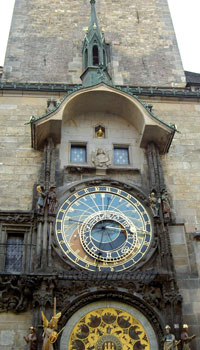 Jayanta Acharya, 31, is a young guru of astronomy in Kathmandu's Balmiki College. He's also committed to taking the science to ordinary citizens.
Jayanta Acharya, 31, is a young guru of astronomy in Kathmandu's Balmiki College. He's also committed to taking the science to ordinary citizens.
The college is Nepal's only centre for the ancient sciences. Two shastras (ancient knowledge) are taught there: Falit Jyotish (pure astrology) and Siddhanta Jyotish (astronomy). Jayanta teaches astronomy, touching on the achievements of modern and ancient astronomers like Copernicus, Galileo, Ptolemy, Bhaskaracharya, Bramhagupta, and Aaryabhatta.
Jayanta remembers being thrilled as a child, looking at the night sky with his father, Professor Shamba Raj Acharya, head of the Jyotish Faculty at Balmiki.
The young guru wants to do the same for others, and organises public observations of celestial events at the college. If you want to see a Solar Eclipse or the Transit of Venus, Balmiki College is the only place that allows you access to a modern telescope.
In August this year, Jayanta was the only Nepali participant at the 26th International Astronomical Union (IAU) meeting in Prague, where Pluto was deemed not to be a planet. Jayanta paid his own way, but got to check out the Prague astronomy clock tower (pictured), and meet fellow astronomers.
As a result of Jayanta's visit, though, we know that there are astronomers in China, Japan, and NASA who'd jump at the chance to establish observatories in Nepal, if the government hoops here made the effort worth it.
But we don't have to wait for foreign-funded facilities to enjoy our night skies. Jayanta plans to build a sundial at the college to teach students how ancient scientists kept time. He'll also be organising a series of public observation programs next year for the 50th anniversary of the International Heliophysical Year (IHY), an international organisation that takes astronomy to the general public.
It's a shame that instead of supporting initiatives like Jayanta's, the government pampers the bureaucrats at the Ministry of Science & Technology (MoST) and NAST.
November highlights:
The Sun is in Libra for most of November but crosses to Scorpius on the 23rd before moving to Ophiuchus on 30th.
Mercury's Transit will take place on the night of 8-9 November, when the planet crosses the disk of the Sun. The 'greatest transit' happens at 21:41:04 UT. Folks in the Americas and the Pacific will be positioned correctly to see it.
Venus is very close to the Sun all month, but towards the end you might see the Evening Star after the sunset.
Mars, a morning object, is in Libra, and difficult to see it in the predawn glow. By the end of the month, though, you might see Mars rise almost an hour before the Sun.
Jupiter is at conjunction (behind the Sun) on 21 November to become a morning object and will thus be invisible this month.
Saturn, in Leo, is the only planet well-placed for viewing this month. It rises in the east late in the evening, and by dawn is high in the south. Saturn will meet the Moon on the night of 12-13 November.
Meteors The Taurids meteor shower peaks on 3 November but you'll see less than ten an hour. The Leonids should be more interesting. It starts on 15 November, peaking on the 17th, with one meteor every five minutes, and tailing off by the 19th. The Leonids tend to be fast-moving, and the brighter ones often leave persistent trains. Train your binoculars to the radiant point, Leo's sickle.
[email protected]


